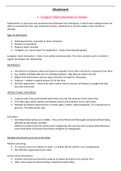Summary
Summary AQA A Level Psychology - Attachment Revision Notes
- Module
- Attachment
- Institution
- AQA
In this document, all theories and statistics related to Attachment are simply broken down for easier reading. All subsections have appropriate theories. Although summarised, each theory includes weaknesses, strengths and important statistics. Diagrams have been included to help remember all the th...
[Show more]



